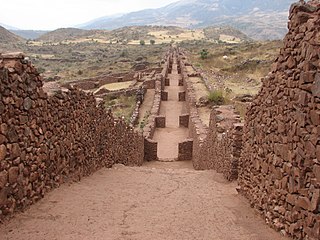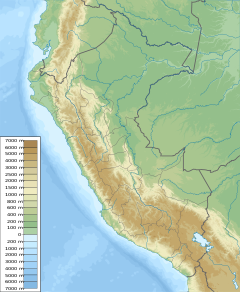
Spirit Cave is an archaeological site in Pang Mapha district, Mae Hong Son Province, northwestern Thailand. It was occupied 12,000 to 7,000 uncalibrated radiocarbon years ago by prehistoric humans of the Hoabinhian culture.

Pikillaqta is a large Wari culture archaeological site 20 kilometres (12 mi) east of Cusco in the Quispicanchi Province.

Tambomachay is an archaeological site associated with the Inca Empire, located near Cusco, Peru. An alternate Spanish name is El Baño del Inca.

Guitarrero Cave is located in the Callejón de Huaylas valley in Yungay Province, in the Ancash region of Peru. The cave stands 50 m (160 ft) above the Santa River and 2,580 m (8,460 ft) meters above sea level.
Coxcatlan Cave is a Mesoamerican archaeological site in the Tehuacán Valley of Puebla, Mexico. It was discovered by Richard MacNeish in the 1960s during a survey of the Tehuacán Valley. It was the initial appearance of three domesticated plants in the Tehuacan Valley and allowed an evaluation to be done again of the overall temporal context of the plant domestication in Mexico. In addition to plants, Coxcatlan Cave also provided nearly 75 percent of the classified stone tools from excavation.
Inka Mach'ay is an archaeological site in Peru. It is situated in the Huancavelica Region, Tayacaja Province, Ñahuimpuquio District.

Inka Mach'ay is an archaeological site in Bolivia. It is situated in the Chuquisaca Department, Oropeza Province, Chuquisaca Municipality, at a height of 3,510 metres (11,516 ft). Inka Mach'ay was declared a National Monument on May 27, 1958, by Supreme Decrete No. 4954.
Quillcay Machay or Qillqay Mach'ay is an archaeological site in Peru. It is situated in the Huánuco Region, Huamalíes Province, Singa District. The site is known for its rock paintings. It was declared a National Cultural Heritage of Peru by Resolución Directoral No. 533/INC on June 18, 2002.
Tampu Mach'ay or Tampumach'ay is an archaeological site in Peru. It is located in the Huancavelica Region, Tayacaja Province, Acostambo District. Tampu Mach'ay is situated near the main square of Acostambo at a height of about 3,400 metres (11,155 ft).
Ayamachay is an archaeological site with rock paintings in Peru. It is situated in the Cusco Region, Canchis Province, Combapata District, above the left bank of the Salqa or Salcca river near the village of Oroscocha or Oroscocha. The paintings are predominantly white and show abstract or geometrical figures.

Kunturmarka is an archaeological site in Peru. It is situated in the Ayacucho Region, Huanta Province, Huamanguilla District.

Hatun Machay is a rock forest with archaeological remains in Peru. It was declared a National Cultural Heritage by Resolución Directoral No. 944/INC-2010 on May 7, 2010. Hatun Mach'ay is situated on the western side of the Cordillera Negra in the Ancash Region, Recuay Province, Pampas Chico District, at a height of about 4,200 metres (13,780 ft).

Piqui Machay is a mountain in the Andes of Peru, about 4,800 metres (15,748 ft) high. It is situated in the Cusco Region, Quispicanchi Province, Marcapata District. It lies southeast of the mountains Vizcachani, Allincapac and Huanacune. At the northern slopes of Piqui Machay there is a little lake named Jomercocha.
Pusuquy Pata or Ch'illiku Pampa is an archaeological site in the Ayacucho Region in Peru. It is located in the Huanta Province, Huanta District. The site consists of tombs of the Wari culture.
Kanichi is an archaeological site in Peru. It was declared a National Cultural Heritage by RDN No. 197/INC on April 2, 2003. Kanichi lies in the Ayacucho Region, Lucanas Province, Carmen Salcedo District.

Yanaqucha is a mountain in the Andes of Peru, about 4,800 metres (15,748 ft) high. It is situated in the Cusco Region, Quispicanchi Province, on the border of the districts of Marcapata and Camanti. It lies northeast of Piki Mach'ay.
Killa Mach'ay is an archaeological site with rock paintings and petroglyphs in Peru. It is situated in the Huancavelica Region, Acobamba Province, Acobamba District. The site consists of caves with images of llamas, lines and people. It is situated at a height of 3,400 metres (11,155 ft).

Saqra Mach'ay is a mountain in the Andes of Peru, about 4,600 m (15,100 ft) high. It is located in the Pasco Region, Daniel Alcides Carrión Province, Yanahuanca District. Saqra Mach'ay lies southwest of Puka Mach'ay.

Saqra Mach'ay is a mountain in the Andes of Peru, about 4,750 m (15,580 ft) high, in the Pasco Region, Pasco Province, Ticlacayan District. It lies northwest of the Waqurunchu mountain range, southeast of Wamanripayuq.

Mata Mach'ay is a mountain in the Andes of Peru which reaches a height of approximately 4,400 metres (14,436 ft). It is located in the Junín Region, Jauja Province, Pomacancha District.







